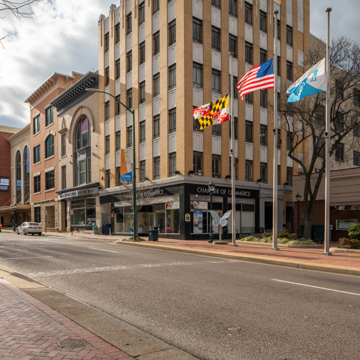The neighborhood around the intersection of Washington and Potomac streets at the Hagerstown Public Square represents the city’s commercial core and its exponential growth around the turn of the twentieth century. Washington Street is also U.S. 40, or the former National Road, as it travels through downtown Hagerstown, and Potomac Street is MD 65. Most of the prominent buildings now near this key historic crossroads date from around 1880 to 1930. However, the western anchor for this area is the Washington County Courthouse (1872; 95 W. Washington), a red brick Second Empire building designed by the Philadelphia firm of Sims and Sims. Another key institutional building is the former Washington County Free Library (1901–1902, Bruce Price; 21 Summit), a diminutive Beaux-Arts classical building.
At the public square, the six-story Ramacciotti Professional Arts Building (1936–1937; 1–3 S. Potomac) stands as Hagerstown’s most substantial office tower. It was designed by Hagerstown architect Amos J. Klinkhart using a restrained Art Deco idiom for client Domenico Ramacciotti, an Italian immigrant with a produce wholesale business in Hagerstown. Klinkhart also designed the vaguely Colonial Revival Hagerstown City Hall a few years later (1939–1940; 1 E. Franklin).
Several commercial hotel buildings built to serve railroad and automobile travelers are still extant although repurposed for new uses, including the Hotel Dagmar (1910; c. 1929 two upper floors; 50 Summit), an eight-story reinforced concrete structure with simplified Renaissance Revival details; Hamilton Hotel (1880s; 90–96 W. Washington); Colonial Hotel (c. 1910; 57–59 S. Potomac), and the ten-story Colonial Revival Alexander Hotel (1927–1929; 3 E. Washington) on the public square. The elaborate terra-cotta facade of the Colonial Theater (1914; 12–14 S. Potomac) by local architect Harry E. Yessler marks the downtown entertainment district, although the interior has been extensively altered and occupied by a church since the 1970s.







